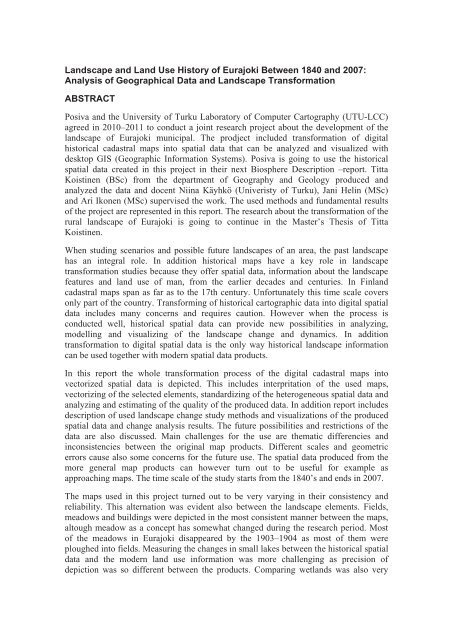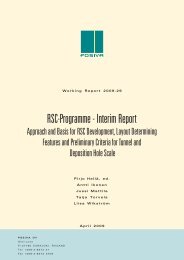Create successful ePaper yourself
Turn your PDF publications into a flip-book with our unique Google optimized e-Paper software.
Landscape and Land Use History of Eurajoki Between 1840 and 2007:Analysis of Geographical Data and Landscape TransformationABSTRACT<strong>Posiva</strong> and the University of Turku Laboratory of Computer Cartography (UTU-LCC)agreed in 2010–2011 to conduct a joint research project about the development of thelandscape of Eurajoki municipal. The prodject included transformation of digitalhistorical cadastral maps into spatial data that can be analyzed and visualized withdesktop GIS (Geographic Information Systems). <strong>Posiva</strong> is going to use the historicalspatial data created in this project in their next Biosphere Description –report. TittaKoistinen (BSc) from the department of Geography and Geology produced andanalyzed the data and docent Niina Käyhkö (Univeristy of Turku), Jani Helin (MSc)and Ari Ikonen (MSc) supervised the work. The used methods and fundamental resultsof the project are represented in this report. The research about the transformation of therural landscape of Eurajoki is going to continue in the Master’s Thesis of TittaKoistinen.When studing scenarios and possible future landscapes of an area, the past landscapehas an integral role. In addition historical maps have a key role in landscapetransformation studies because they offer spatial data, information about the landscapefeatures and land use of man, from the earlier decades and centuries. In Finlandcadastral maps span as far as to the 17th century. Unfortunately this time scale coversonly part of the country. Transforming of historical cartographic data into digital spatialdata includes many concerns and requires caution. However when the process isconducted well, historical spatial data can provide new possibilities in analyzing,modelling and visualizing of the landscape change and dynamics. In additiontransformation to digital spatial data is the only way historical landscape informationcan be used together with modern spatial data products.In this report the whole transformation process of the digital cadastral maps intovectorized spatial data is depicted. This includes interpritation of the used maps,vectorizing of the selected elements, standardizing of the heterogeneous spatial data andanalyzing and estimating of the quality of the produced data. In addition report includesdescription of used landscape change study methods and visualizations of the producedspatial data and change analysis results. The future possibilities and restrictions of thedata are also discussed. Main challenges for the use are thematic differencies andinconsistencies between the original map products. Different scales and geometricerrors cause also some concerns for the future use. The spatial data produced from themore general map products can however turn out to be useful for example asapproaching maps. The time scale of the study starts from the 1840’s and ends in 2007.The maps used in this project turned out to be very varying in their consistency andreliability. This alternation was evident also between the landscape elements. Fields,meadows and buildings were depicted in the most consistent manner between the maps,altough meadow as a concept has somewhat changed during the research period. Mostof the meadows in Eurajoki disappeared by the 1903–1904 as most of them wereploughed into fields. Measuring the changes in small lakes between the historical spatialdata and the modern land use information was more challenging as precision ofdepiction was so different between the products. Comparing wetlands was also very
















